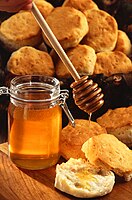
Photo from wikipedia
Honey is a complex sweet liquid with greater viscosity made by bees. It is graded by color, with clear, golden amber and darker honey. The flavor of each type of… Click to show full abstract
Honey is a complex sweet liquid with greater viscosity made by bees. It is graded by color, with clear, golden amber and darker honey. The flavor of each type of honey varies, depending on the types of flowers.1 Honey is a complex food substance, comprised of approximately 200 deferent substances, including sugar, water, proteins, vitamins, minerals, polyphenolic compounds and plant derivatives.2,3 Honey can be classified as honeydew and blossom. Honeydew honey is produced by collection of living plant, aphid and insect secretions whereas blossom honey is produced by collection of flower nectar and characterized by pollen content. Blossom honey can be subdivided into uni-floral, which is from one flower species, or multiflora where multiple sources of flower species. The composition of active compounds present within plant nectar can vary, depending on geographical location and climate conditions.4,5 Honey has antimicrobial and antioxidant properties in which the first observations of the antimicrobial activity of honey described in 1892. The honey has then been observed to have a broad spectrum of activity. It can also inhibit both Gram positive and Gram negative organisms including Escherichia coli, Pseudomonas aeruginosa, Klebsiella pneuomniae, Staphylococcus aureus, Bacillus subtilis and Listeria monocytogens and their multidrug-resistant counterparts.6,7 Observing the broad spectrum of activity showed by honey, mostly against MDR and many types of antibiotics have led to investigate honey–antibiotic synergy with some promising effects.8 Honey contain different types of substances contributing to eradicate and kill microbial pathogen and these substances are classified into two categories, being direct inhibitory factors affecting the cellular mechanism such as polyphonic component, hydrogen peroxide, methylglyoxal (MGO) and bee-defensin1, and indirect inhibitory factors which have a wider ranging effect on the bacterial cell such as high osmatic pressure, high sugar content and low pH.9 A recent study showed that Manuka +20, Manuka +16 and Manuka +10 have strong antibacterial activities against both sensitive and resistant P. aeruginosa strains in addition to P. aeruginosa ATCC 27853 which served as control. A previous study showed that Manuka honey of lower UMF grade demonstrated equal to significantly increased antimicrobial activity compared to higher ABSTRACT Honey is a complex sweet highly viscous liquid and is composed of various ingredients such as sugar, proteins, minerals, and polyphenolic compounds. Honey is used in traditional medicine systems for centuries because of its ability to inhibit the pathogenesis of various diseases through modulating various biological activities. In this study, antimicrobial potential of different types of honey was tested against selected pathogenic bacterial strains through agar well diffusion method. Four types of honey were used in the present investigation, and the potential antimicrobial activities of these varieties were further compared with that of antibiotics commonly used against targeted microbial strains. Among all of the four tested honey, three types were classified as blossom honey, being Talha (Acacia sp) honey (TH), Zahoor (mixed flower) honey (ZH), and Manuka (Leptospermum based honey) honey (MH). Both gram positive and gram negative bacterial species were used for this investigation. The pathogenic gram-positive bacterial strains included Staphylococcus aureus ATCC 29213, Enterococcus faecalis ATCC 29212 and methicillin-resistant Staphylococcus (MRSA) ATCC 43300. Three gram negative bacteria like Escherichia coli ATCC 25922, Klebsiella pneumonia ATCC 700603, and Pseudomonas aeruginosa ATCC 27853 were also used to confirm the antimicrobial activities. As reflected from our study, we found that three varieties of honey including TH, ZH, and MH (with different UMF +20, +16, +5) displayed a broad spectrum antibacterial activity against all tested microbial strains. However, all strains showed a high frequency of resistance to BF honey. Gram-positive (G+) bacteria were found to be more sensitive to all tested honey types except (BF) as indicated by significantly higher zone of inhibition (ZOI) values than those of gram-negative (G-) bacteria. As a conclusion, this study suggests that antimicrobial potential of honey types might be helpful in order to treat the pathogenic microorganisms threatening the public health and changing antibiotics into last-resort drugs.
Journal Title: Pharmacognosy Journal
Year Published: 2021
Link to full text (if available)
Share on Social Media: Sign Up to like & get
recommendations!